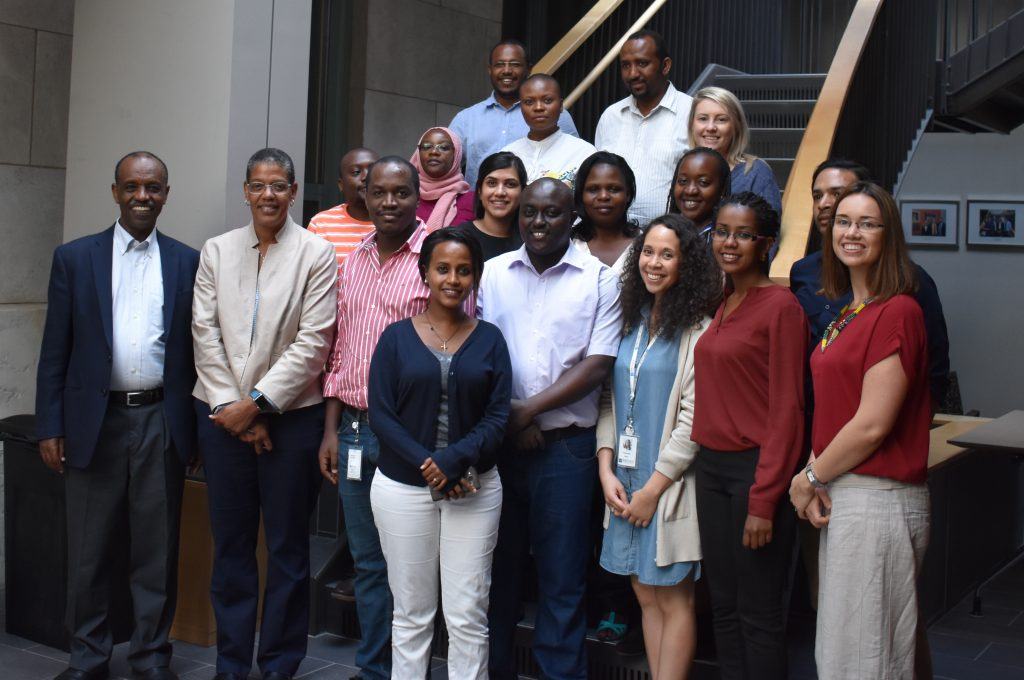
Sense of Purpose Helps Healthy Aging
Having a sense of purpose in life may play an important role in helping people maintain physical function as they age. Older adults who reported having goals for the future or other indicators of a sense of purpose performed better on tests of grip strength and walking speed—two important measures of physical function, the decline of which are associated with morbidity, institutionalization, and mortality—than those who reported having a lower sense of purpose in life. Potential mechanisms for the link between having a purpose in life and physical functioning aren’t fully understood. But based on past research, it’s likely, according to Harvard Chan Research Associate Eric Kim and co-authors, that “people with higher purpose are more proactive in taking care of their health, have better impulse control, and engage in healthier activities.”

Are Bright Nights a Health Risk?
Women who live in areas that are brightly lit at night by artificial light may have a higher risk of breast cancer than those who live in more dimly lit neighborhoods, especially if they work night shifts, according to a new study. Lead author Peter James, SD ’12, now assistant professor at Harvard Medical School and Harvard Pilgrim Health Care Institute, hypothesizes that exposure to light at night may lead to decreased levels of the hormone melatonin, which can disrupt circadian rhythms—our internal “clocks” that govern sleepiness and alertness—and, in turn, lead to increased breast cancer risk and other health consequences.
Sniffing Out a Better Tuberculosis Vaccine
Researchers in the Department of Immunology and Infectious Diseases are working to expedite the discovery of a new and improved tuberculosis (TB) vaccine. To test whether putative vaccines prevent progression of the infection, Postdoctoral Fellow Jeffrey Wagner and colleagues hope to first inoculate small groups of people and then expose them to a genetically engineered strain of Mycobacterium tuberculosis. If the vaccine proves ineffective, the genetically engineered strain can be eliminated quickly and efficiently, “curing” the patient. Such studies have been tried with other diseases but not with naturally occurring TB, because it requires several months of antibiotic treatment to eliminate the infection. There is also currently no good way to measure the amount of bacteria in the lungs at any given time, providing an additional challenge to vaccine testing. Knowing that compounds made by bacteria in the lungs can show up in breath, the team came up with a novel solution— engineer the tuberculosis bacteria to give off scents, such as wintergreen, to make them more detectable during a trial.
Examining the Public Health Consequences of War In Syria

The civil war in Syria, now in its seventh year, has taken a devastating toll: thousands of lives lost, forced migration at levels unseen since World War II, homes and infrastructure obliterated, health facilities and workers targeted in attacks. Accurately documenting the war’s impact on the civilian population has been extremely difficult. To help with this effort, The Lancet convened a commission to examine the war through the lens of public health. Jennifer Leaning, François-Xavier Bagnoud Professor of the Practice of Health and Human Rights at the Harvard Chan School, is one of three co-chairs named in December 2016 to lead the 15-month study, which is hosted by the American University of Beirut and anticipates publishing its final report in The Lancet in May 2018. Leaning, a faculty associate at Harvard’s Weatherhead Center for International Affairs, spoke to its Epicenter newsletter about the difficulties of conducting epidemiological research in an unstable society. She said, “Health policy crumbles into dust when you’re dealing with the narrow malignant focus of governments at war.”
Building the Genetic Map of Breast Cancer Risk
Two large genomewide association studies of thousands of women have identified 75 new genetic regions that influence the risk of breast cancer. The studies were conducted by a large international team whose leadership included Harvard Chan professors Peter Kraft, professor of epidemiology, and David Hunter, Vincent L. Gregory Professor in Cancer Prevention, Emeritus. The findings add to the roughly 100 known breast cancer risk regions in the human genome, providing information that could help identify women at high risk of breast cancer, as well as guidance for further research on the biology of breast cancer development and progression. Genetic regions identified in the studies included those linked with risk of estrogen-receptor-negative breast cancer, an aggressive form that does not respond to hormonal treatments.
Report Outlines Hazards of Low-Dose Exposure to Endocrine-Disrupting Chemicals
A report found that maternal exposure during pregnancy to specific phthalates— such as DEHP, a type of endocrine-active chemical (EAC) used in some plastics— was linked in male children to an indicator of androgen levels during the fetal male programming window, and that in utero exposure to PBDEs (another class of EAC used as flame retardants) may affect intelligence in children. According to the researchers, more information is needed on the metabolism of these chemicals within the body to better evaluate an EAC’s potential to cause health effects in humans at low doses. The authors recommend increased surveillance of a variety of data sources for signs that a chemical may be affecting health, systematic reviews of evidence from human and experimental animal studies, and updating chemical assessment protocols. The report, by the National Academies of Sciences, Engineering, and Medicine, on endocrine-related low-dose toxicity of chemicals, was released on July 18, 2017. Russ Hauser, chair of the Department of Environmental Health, was a member.
Boosting African Research Collaborations on the Genetics of Neuropsychiatric Disorders

This past summer, 17 early-career African scientists came to the School for an introductory workshop on the field of neuropsychiatric genetics, attending sessions ranging from a primer on autism genetics to the mechanics of study design and data analysis. They made up the inaugural cohort of research fellows for the GINGER (Global Initiative for Neuropsychiatric Genetics Education in Research) program, a collaboration among the School, the Stanley Center for Psychiatric Research at the Broad Institute of MIT and Harvard, and multiple universities and institutes in East and South Africa. The two-year training program aims to boost genetics research capacity in Africa by training and mentoring the fellows to become independent researchers in neuropsychiatric genetics and be able to pass on what they’ve learned through GINGER to others at their home institutions. Organizers also hope that GINGER fellows will form new study cohorts back home and ultimately help close gaps in knowledge about mental health in African populations.

Thousands of New Microbial Communities Profiled From Human Body
A new study of the human microbiome—the trillions of microbial organisms that live on and within our bodies—has analyzed thousands of new measurements of microbial communities from the gut, skin, mouth, and vaginal microbiomes, yielding new insights into the role these microbes play in human health. The new findings, by senior author Curtis Huttenhower, associate professor of computational biology and bioinformatics at the Harvard Chan School; lead author Jason Lloyd-Price, postdoctoral fellow at the Harvard Chan School; and Owen White, a key collaborator at the University of Maryland, represent a three-fold expansion of data from the National Institutes of Health Human Microbiome Project. Researchers will now be better able to identify characteristics that are unique to an individual’s microbes—just as some human genome variants are unique to each individual—and track them across the body and over time.







